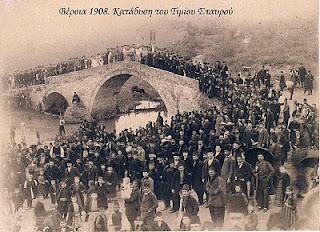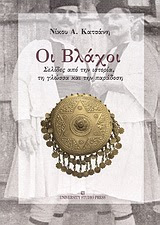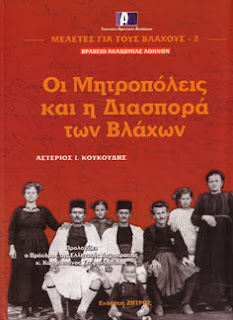 |
| ''Λιγουτσιάρης'' |
Σε περσινό σημείωμά μας αναφερθήκαμε στους ‘Λιγουτσιάρηδες’ των Βλάχων της Βέροιας επιγραμματικά, γιατί ασχοληθήκαμε με τις μεταμφιέσεις στο Δωδεκαήμερο, γενικά στη Ελλάδα .
Ωστόσο πρέπει να υπενθυμίσουμε, περιληπτικά, ότι οι μεταμφιέσεις αυτές ήταν ένας μικρός θίασος ανδρών (προάγγελος του θεάτρου), το έθιμο έχει τις ρίζες του στην αρχαιότητα (λατρεία του Διόνυσου) με σκοπό την απομάκρυνση των κακών πνευμάτων (με τον εκκωφαντικό κρότο των κουδουνιών), τον θάνατο του παλιού, τον ερχομό του νέου και γενικά την επικράτηση του παλιού στο νέο.
Γι'αυτό στις μικρές αυτές ομάδες - θιάσους, βλέπουμε μορφές γέρων και μορφές νέων, όπου τελικά με πάλη (μέχρι και θανάτου ακόμα) επικρατούν οι νέοι και δυνατοί . Αρκετά είναι τα τοπωνύμια στη Ελλάδα με ονόματα, όπως ‘σκοτωμένοι’, ‘αρσάλια’ (νεκροταφεία). Αυτό που επιζητείται, σε τελική ανάλυση, είναι η γονιμότητα, η βλάστηση, η ζέστη, το φως, κόντρα στην μη γονιμότητα, στο κρύο και στο σκοτάδι.
Μιλήσαμε για λατρεία του Διόνυσου γιατί αυτός δεν είναι μόνο ο θεός του κρασιού και προστάτης των αμπελιών στου Αρχαίους Έλληνες, αλλά και θεός, που πεθαίνει και ξαναγεννιέται κάθε χρόνο. Άλλωστε ο φαλλός (σύμβολο γονιμότητας), οι προσωπίδες με τις κεφαλαργιές και τα κέρατα των ζώων, που υπάρχουν στις μεταμφιέσεις αυτές και που ταυτόχρονα τις βλέπουμε στην λατρεία του Διόνυσου στη Αρχαία Ελλάδα, μας δυναμώνουν την πεποίθηση ότι πρόκειται για Διονυσιακό κατάλοιπο.
Το έθιμο το συναντάμε σε όλες τις εποχές αργότερα (Ρωμαιοκρατία, Βυζάντιο, Τουρκοκρατία) και ασφαλώς πέρασε και στον χριστιανισμό, όπου διατηρήθηκε (όσο μπόρεσε) μέχρι τις ημέρες μας.
Τα ονόματα αυτών των ομάδων, που συναντάμε ιδιαίτερα στην Βόρειο Ελλάδα (Θεσσαλία , Ήπειρο και Μακεδονία) και φαίνεται, πεντακάθαρα, η ευρεία εξάπλωση του εθίμου στους ελληνικούς πληθυσμούς, είναι:
Αράπηδες, Αραπκοί, Αργκουτσιάρια, Αλήδες, Γκαμήλα με τον Ντιβιτζή, Καμήλα, Κουδουνάδες, Καραβασλάδες, Καλινδράδες, Καλκάντζαροι, Καρναβάλια, Λαγκατζάρια, Λιουγκατζιάρια, Λογκατσάρια, Μπαμπούγεροι, Μπαμπαϊούρδις, Μωμόγεροι, Μπουσιαραίοι, Μπαμποέρηδες, Μπάμπιντεν, Μπαμπαλιούρδες, Μπουμποσάρια, Ντυλιάροι, Ποτουρλίδες, Ραγκουτσάρια, Ρουγκάτσια, Ρογκατζάρια, Ρουγκανάδες, Ρογκατσάδες, Ρούγκοι, Σουρβάροι, Σουρβατζήδες, Τζαμάλες, Φουστανελάδες και Νύφες (Εσκιάροι και Τζβοκάροι), κλπ.
Το έθιμο το ‘Λιγουτσιάρηδων’ στη Βέροια έχει ως εξής: Τα μικρά παιδιά μέχρι την ηλικία των 12 περίπου ντυμένοι ‘λιγουτσιάρηδες' πριν ξημερώσει, την πρώτου του χρόνου, έλεγαν τα κάλαντα στα σπίτια των συγγενών και φίλων τους. Θα εξηγήσουμε παρακάτω την φορεσιά των ‘Λιγουτσιάρηδων’.












